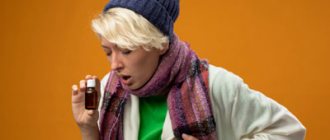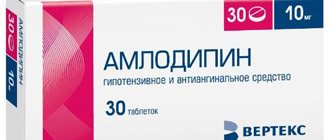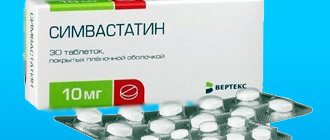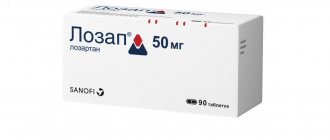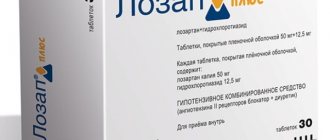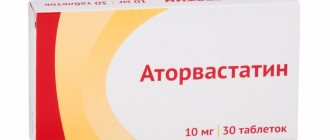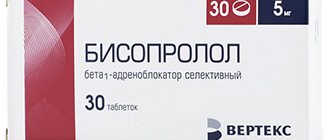In the case of chronic heart failure, as well as in stressful situations, physical and nervous exhaustion, myocardial cells and neurons often suffer. They experience oxygen starvation, which negatively affects metabolic processes. To treat and prevent these conditions, Eltacin tablets are used. They are popular among patients - more than 80% of reviews are positive.
Pharmacodynamics
Eltacin® is a combination drug that contains a mixture of non-essential amino acids: glycine, glutamic acid and cystine, which are metabolic regulators: increasing the intracellular concentration of glutathione and the activity of glutathione-dependent enzymes, normalizing redox processes and oxygen utilization in tissues, due to which the drug:
— exhibits antioxidant (reduces the content of free radicals, peroxide compounds, malondialdehyde) and antihypoxic (increases the body’s resistance to oxygen deficiency, enhancing the processes of ATP synthesis) effect;
— increases myocardial contractility;
- increases physical performance;
— improves the quality of life of patients with chronic heart failure (increases social adaptation, improving psycho-emotional state);
— accelerates the recovery of performance after intense physical activity in children.
Instructions
Composition/description
Registration number: LS-000499
Trade name: Eltacin®
Group name:
Glycine + Glutamic acid + Cystine.
Dosage form:
sublingual tablets.
Composition (per tablet):
active ingredients: glycine – 70 mg, glutamic acid – 70 mg, cystine – 70 mg; excipients: methylcellulose – 7.8 mg, magnesium stearate – 2.2 mg.
Description:
round biconvex tablets of white or white with a yellowish tint.
Pharmacotherapeutic group:
antioxidant agent.
ATX code:
C01EX.
Pharmacological properties
Pharmacodynamics:
Eltacin® is a combination drug that contains a mixture of non-essential amino acids: glycine, glutamic acid and cystine. The components of Eltacin® are metabolic regulators that increase the intracellular concentration of glutathione and the activity of glutathione-dependent enzymes, normalizing redox processes and oxygen utilization in tissues, due to which the drug:
- exhibits antioxidant (reducing the content of free radicals, peroxide compounds, malondialdehyde) and antihypoxic effects (increasing the body's resistance to oxygen deficiency, enhancing the synthesis of adenosine triphosphoric acid (ATP));
- increases myocardial contractility;
- increases physical performance;
- improves the quality of life of patients with chronic heart failure (increasing social adaptation, improving psycho-emotional state);
- accelerates recovery of performance after intense physical activity in children.
Pharmacokinetics:
glycine penetrates into most biological fluids and tissues of the body, incl. into the brain, does not accumulate in tissues, is metabolized to water and carbon dioxide. When taken, glutamic acid is well absorbed and penetrates the blood-brain barrier and cell membranes. It is utilized during metabolism, 4–7% is excreted unchanged by the kidneys. After administration, the concentration of cystine gradually increases, reaching a maximum after 30 minutes, and then slowly decreases. Cystine does not accumulate and is not toxic.
Indications for use
Autonomic dysfunction syndrome in adults and children over 12 years of age.
Prevention of chronic physical overstrain and recovery after intense physical activity during sports in children aged 11 to 15 years.
Chronic heart failure of functional class I–III according to the NYHA classification in adults (against the background of standard therapy).
Chronic heart failure of functional class I–II according to the NYHA classification in children over the age of 12 years (against the background of standard therapy).
Contraindications:
hypersensitivity to the drug, children under 11 years of age (efficacy and safety have not been established).
Precautions for use:
does not require special precautions.
Use during pregnancy and breastfeeding:
No separate studies have been conducted. Not recommended for use during pregnancy and breastfeeding.
Directions for use and doses
Sublingually. The tablet can also be chewed and held in the mouth under the tongue until completely dissolved.
Autonomic dysfunction syndrome in adults and children over 12 years of age: 1 tablet 3 times a day sublingually, course of treatment from 1 to 3 months depending on the severity of the disease, repeated courses are prescribed on the recommendation of a doctor.
Prevention of chronic physical overexertion in children aged 11 to 15 years: 1 tablet 2 times a day for 2–3 weeks.
During the recovery period after intense physical activity when playing sports in children aged 11 to 15 years: 1 tablet 3 times a day for 2 weeks.
Chronic heart failure of functional class I–III according to the NYHA classification in adults: 1 tablet 3 times a day sublingually, course of treatment from 1 to 3 months depending on the severity of the disease, repeated courses are prescribed on the recommendation of a doctor.
Chronic heart failure of functional class I–II according to the NYHA classification in children over 12 years of age: 1 tablet 3 times a day sublingually, course of treatment from 1 to 3 months depending on the severity of the disease, repeated courses are prescribed on the recommendation of a doctor.
Additional Information
Side effect.
Allergic reactions are possible.
Overdose.
No cases of overdose have been identified.
Interaction with other drugs.
Can be taken simultaneously with angiotensin-converting enzyme (ACE) inhibitors, beta-blockers, diuretics, aldosterone antagonists, organic nitrates and slow calcium channel blockers.
The possibility of the drug influencing the ability to drive vehicles and other potentially dangerous mechanisms:
does not affect.
Release form.
Sublingual tablets, 70 mg+70 mg+70 mg. 30 tablets in a blister pack made of polyvinyl chloride film and aluminum foil. 1 blister pack along with instructions for use in a cardboard pack.
Storage conditions:
at a temperature not exceeding 25 °C in the original packaging (blister packaging in a pack). Keep out of the reach of children.
Best before date.
3 years. Do not use after the expiration date indicated on the package.
Vacation conditions.
Available without a prescription.
Indications for the drug Eltacin®
chronic heart failure of functional class I–III according to the NYHA classification in adults (against the background of standard therapy);
chronic heart failure of functional class I–II according to the NYHA classification in children aged 12 to 18 years (against the background of standard therapy);
autonomic dysfunction syndrome in children aged 12 to 18 years;
prevention of chronic physical overstrain and recovery after intense physical activity when playing sports in children aged 11 to 15 years.
Eltacin's analogs
Level 4 ATX code matches:
Validol
Tonginal
Tricardin
Instenon
Pumpan
Barboval
Corvalment
Antioxidant agents - Mexidol , Emoxibel , Emoxipin , Neurox.
Directions for use and doses
Sublingual. The tablet can also be chewed and held in the mouth under the tongue until completely dissolved.
CHF I–III functional class according to the NYHA classification in adults; CHF functional class I–II according to the NYHA classification in children aged 12 to 18 years; autonomic dysfunction syndrome in children aged 12 to 18 years: 1 table. 3 times a day, the course of treatment is from 1 to 3 months, depending on the severity of the disease, repeated courses are prescribed on the recommendation of a doctor.
Prevention of chronic physical overexertion in children aged 11 to 15 years: 1 table. 2 times a day for 2–3 weeks.
During the recovery period after intense physical activity when playing sports, children aged 11 to 15 years - 1 table. 3 times a day for 2 weeks.
Reviews about Eltatsin
The drug has a diverse effect - mainly on the central nervous system and autonomic system , as well as on metabolic processes in the myocardium . The body's defense systems against stress are directly related to the amino acid glycine , which has a stress-protective effect, improves memory and attention, and reduces psycho-emotional stress. Glutamic acid increases resistance to hypoxia , improves oxygen transport to tissues and its rational use.
Cystine is considered as a detoxifier and antioxidant . In general, the drug is considered as an antioxidant . The use of Eltacin is indicated for many diseases and conditions, but reviews more often contain information about its use for functional disorders of the autonomic nervous system in adults and children. All patients who left reviews are satisfied with its effect - they note its effectiveness, low price and the absence of adverse reactions.
- “... My daughter was prescribed for VSD and took it for about two months. Everything got better: sleep was restored, my hands stopped getting cold, the headaches stopped.”
- “... The remedy is really good, it was prescribed for a 10-year-old child for VSD.”
- “... The drug coped with our problem - our daughter is in adolescence and has a constant decline in mood or outbursts of emotions with scandals, weakness and headache.”
- “...Took my 14-year-old daughter, they are very effective for VSD: headaches and mood swings disappeared. I thought it was a transitional age, but it turned out to be a disease.”
- “...Very good and safe tablets. They were prescribed to my 13-year-old son and he took it for 1.5 months. Weakness, headaches and decreased attention went away. I began to do well in my studies. I'm glad".
- “... The drug is great - I took it for 2 months, the fatigue, hysterics and irritability, constant headaches in the evening went away.”
Drug elimination of symptoms of vegetative-vascular dystonia
Symptomatic treatment is aimed at eliminating the manifestations of vegetative-vascular dystonia.
- For rapid heartbeat and periodic surges in blood pressure, beta-blockers are indicated.
- For VSD and panic attacks, taking tranquilizers is indicated.
- Heart pain can be relieved with sedatives. For bradycardia (heart rate less than 50 beats per minute), it is recommended to take a drug that stimulates heart contractions.
- Vasodilators are also necessary for VSD. ACE inhibitors have this effect.
- If pain (in the abdomen, joints, muscles, heart) due to VSD cannot be relieved, doctors may prescribe tricyclic or serotonergic antidepressants. Typically, a short course of taking these drugs quickly relieves pain.
- With the hypertensive type of vegetative-vascular dystonia, agents for the blood vessels of the brain are needed that improve blood circulation. These drugs will relieve dizziness due to VSD caused by high blood pressure.
- If constipation appears against the background of VSD, then you should not only adjust your diet, where fiber-rich foods will predominate, but also, if necessary, take laxatives recommended by your doctor.
- If the patient has a tendency to diarrhea, he, on the contrary, needs to limit the consumption of foods containing fiber and take fixatives as necessary. Also in this case, sorbents can be used.
- To eliminate signs of venous insufficiency, venotonic drugs may be prescribed. In addition, such tablets help with headaches due to VSD and eliminate tinnitus.
- For headaches due to low blood pressure, it is recommended to take tonics.
Thus, along with the treatment of the underlying pathology, a fairly wide range of tablets for VSD are used to eliminate the unpleasant symptoms of vegetative-vascular dystonia.
Causes of vegetative-vascular dystonia
The main causes of vegetative-vascular dystonia include the following.
- Prolonged stress.
- Mental trauma.
- Physical overexertion.
- Bad habits (smoking, drinking alcohol).
- Negative environmental factors.
- Hereditary predisposition.
- Psycho-emotional overload.
- Sudden and significant changes in environmental conditions.
- Mental fatigue.
- Age-related hormonal changes.
- Severe intoxication.
In addition to the listed reasons that have a direct impact on the appearance of vegetative-vascular dystonia, there are a number of factors that themselves cannot cause VSD, but reveal a predisposition to it. The longer and stronger their exposure, the higher the likelihood of pathology occurring.
Violation of the vegetative functions of the body is promoted by:
- smoking;
- frequent and prolonged work at the computer;
- frequent abuse of alcoholic beverages;
- lack of sleep;
- uncontrolled medication use;
- frequent consumption of very spicy foods.
Treatment of vegetative-vascular dystonia
If treatment is started in a timely manner, the result in most cases will be positive. However, it may take several months. The duration of therapy directly depends on the form of vegetative-vascular dystonia and varies between 4–10 months. It is impossible to prescribe a universal remedy for VSD that will definitely help overcome the pathology.
The main role in the fight against vegetative-vascular dystonia is played by a healthy lifestyle, feasible physical activity and lack of stress. In addition, to achieve results, you need to give up smoking and drinking alcohol, normalize your work and rest schedule, adhere to proper nutrition, diversifying your diet with vegetables, fruits, nuts and dairy products.
What is prescribed for VSD? Treatment of vegetative-vascular dystonia is a whole range of measures, which may include the following:
- diet;
- taking medications;
- physical therapy;
- breathing exercises;
- acupuncture;
- massage;
- balneotherapy;
- phototherapy;
- psychotherapy;
- physiotherapeutic procedures (massage, breathing exercises, etc.).
There are a lot of drugs prescribed for VSD. Their choice depends on the symptoms of the pathology, the person’s health status, age and other factors. Therefore, only a doctor can tell you what to take for VSD. For each patient, the doctor develops an individual treatment regimen (based on the clinical picture), which may include the following groups of drugs:
- soothing herbal remedies;
- antidepressants;
- tranquilizers and anxiolytics;
- nootropics;
- vascular drugs;
- psychotropic drugs;
- adaptogens, etc.
Why is Eltacin® recommended for increased physical activity from the age of 11?
The need for amino acids in children is higher than in adults. It increases even more during the growth spurts of early adolescence. This is a time of increased load on the child’s heart, which does not have time to increase in response to the intensive growth of the skeleton and blood vessels. The body has compensation mechanisms, but they cannot completely prevent all health problems that a child may be susceptible to during puberty. Therefore, it is important for teenagers to train the heart, but not to subject it to excessive stress. Regular use of Eltacin® improves the adaptive capabilities of the cardiovascular system and prevents the development of myocardial pathology from stress loads. This is especially true for those children who play sports.

